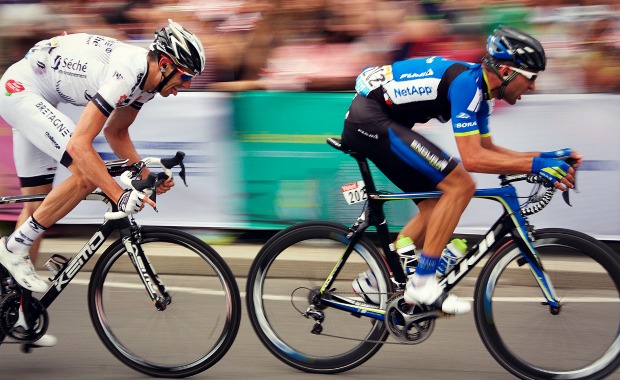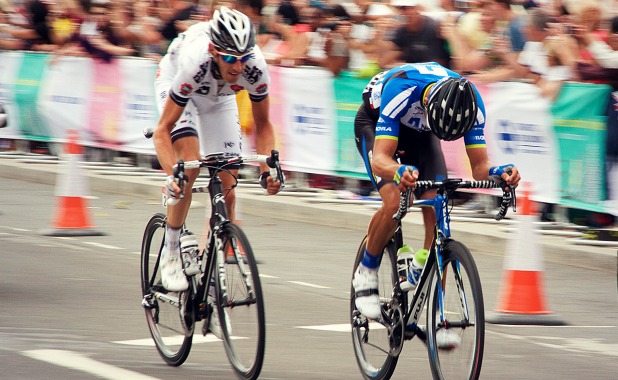
Sprinting is a primary component of cycling for racers and recreational riders alike, but it’s often neglected in training programs. Base miles are in the bank and functional threshold power (FTP) has been raised, and with race season kicking off, it’s now time to build some speed.
Sprinting is about generating high watts, but we have to remember that a watt is defined as how fast you pedal multiplied by how hard you pedal, so don’t start with the assumption that it’s all about strength and mashing pedals.
Cycling Events Near You
To better understand sprinting, lets define the three components of success: acceleration, top end speed, and fatigue resistance.
Acceleration is the ability to increase speed rapidly. Sprinters with great acceleration create immediate gaps and leave other riders fighting to get on the wheel. In my experience, acceleration is driven more by cadence than pure power. Riders with smart gear selection and the ability to spin high-cadence sprints will always out-accelerate riders who love big-gear, heavy-power sprint accelerations. Acceleration rates as measured in WKO4 give us insight into the “snappi-ness” of a rider.
Top end speed is exactly what it sounds like: how fast can you go in an all-out sprint. Top end sprinting is all about generating speed and is a combination of form, cadence, strength, and positioning (aerodynamics). Clearly power plays a role here, but tracking sprint speed gives us insight into the ability to translate watts into speed through quality of form and aerodynamics.
Fatigue resistance is often neglected in sprinting but is very important. Simply put, fatigue resistance is the ability to resist a decline in power over time when sprinting compared to your Pmax (max power output for at least one revolution of the crank). Look at the chart below. This sprinter, at 60 kg, has a solid sprint, but by 30 seconds out, he has declined more than 37% from his Pmax. This type of power decline is a real limiter in longer sprints.
Sprinter Types
High Acceleration and Low Fatigue Resistance
These are the sprinter who can put three bike lengths on you before you know it but cannot sustain the long sprint. This type of sprinter needs to be skilled at positioning in the finishing setup, finding the right lead out, and using it to wait to the last second possible to complete the final sprint. I often recommend that this sprinter be more of a freelancer and focus on racing the other racers, targeting key competitors and looking to pass them late in the sprint. Starting the sprint too early is death to this type of sprinter, as they open a gap, get chased, and end up passed by more fatigue-resistant riders.
Low Acceleration/High Fatigue Resistance
This is the classic long sprinter. The long sprinter wants things fast and hard over the last two kilometers to soften the peloton and prepare his move. For this type of sprinter, I often recommend having a marked sprint point (not as much freelance) on the course that triggers the sprint. This will help the long sprinter focus on the pre-setup lead-in instead of waiting too long to start his move.
High Acceleration/High Fatigue Resistance
This is a rare combination, but it obviously opens up lots of options on how to win. For this type of sprinter, the strategy becomes very specific to the race and to the competitors.

So how can you build your sprint speed?
Now that we understand and see some measurements of the three components of speed and how they affect racing and performance, the final question to be answered is how do we improve our speed? Like with any training, the answer is specificity! In early winter training I typically take a “train your weakness, race your strength” approach, but as I get in season, I eventually focus on strengths.
- During this time of year, add one sprint workout a week (possibly two, depending on overall training volume).
- Complete the sprint workout after a rest day. You want to be as fresh as possible.
- Rest more during sprint workouts. I see lots of sprint workouts with rest intervals too short for muscular recovery. I know your heart rate returns to normal quickly, but give your muscles time to fully recover so you can do each interval 100%.
- Focus on form in each workout. Improving your form will make your top end speed higher by better utilizing the power you put out.
- An advanced tip: learn to be more aerodynamic in your sprinting. As part of your form work, learn to sprint deep in your drops and low over your top tube.
So what type of workout should you do? Here’s a good sprint workout focused on building all three components of speed.
Warm Up: Warm up for 10-20 minutes with some 1-minute high-cadence, low-power efforts to open things up. Make sure you are good and warm.
Main Set: Small chain ring / high cadence sprints
- 3 x 3 – 50 meter sprints in small chain ring (39 x 16/17). Roll onto the sprint line around 8-10 miles per hour with a cadence of 85+ rpm. Jump as hard as you can, quickly accelerate your cadence to the max you can sustain, and hold that for the entire 50 meters. Do NOT shift. Focus on the fastest rpm you can generate (without crashing). Rest for 3-5 minutes between sprints; be very fresh for each. Soft pedal for 5–10 minutes before the next set.
- 3 x 3 – 100 meter sprints in large chain ring. This time roll to the sprint line in your big chain ring and smaller cassette (so maybe 53×19/20) at a speed of about 14-16 mph, again with a cadence of 85+ rpm. Jump as hard as you can and maintain the gear till you hit max cadence, then shift into one harder gear and focus on getting your cadence back up to max as quickly as possible. Hold the cadence till you hit the 100-meter mark. Soft pedal for 5-10 minutes.
- 3 x 3 minutes – 150 meter sprints, high-speed, big-gear version. Using a big gear set such as 53×16, roll up to the sprint line at 22-24 mph, again with cadence over 85 rpm. Jump hard, accelerate to max cadence, shift into one harder gear, get cadence high again, and then shift into one harder gear. Focus on maintaining high cadence to the finish line.
Cool Down: Get in 15-30 minutes of easy spinning home.
Summary
There are a lot of skills to work on for a cyclist. But if you’re racing in organized events or even for the town line sprints, winning or bragging rights come down to the ability to sprint and finish the race. This vital skill is pretty hard to replicate indoors but, now that most of us are able to get outdoors regularly, it is a great time to work on this critical skill. And even if you never race, there is a huge thrill in seeing just how fast you can make your bike fly.Ride fast and have fun!
 Ready to ride? Search for a cycling event.
Ready to ride? Search for a cycling event.

